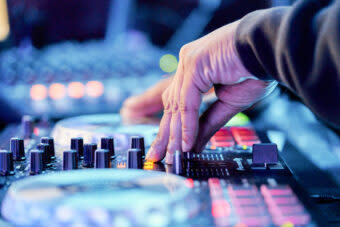10 Essential Dub Techno Albums


More from Spin:
Despite the limitless possibilities implied in the two genres that make up its name, dub techno has a reputation as something of a conservative genre.
The German duo Basic Channel pioneered the sound in the ‘90s, issuing mysterious records with minimalist cover art and astonishing experiments in echo and rhythm that continue to influence electronic artists to this day. The artists on their Chain Reaction label more or less continued in the same style, shrouding their identities with names like “Various Artists” that made some enterprising listeners wonder if they weren’t all the same person. It was only recently that the Japanese producer Shinichi Atobe put rumors to rest that he was actually an alias for one of the label’s European artists by including a physical photo of himself in his 2020 album Yes; perhaps it’s no coincidence that by that point he’d left dub techno behind for sunnier realms of deep house.
Such reticence has little space for the kind of auteur tradition that tends to yield great front-to-back albums, and dub techno thrives in the realm of singles and EPs. Its full-length statements tend to be single or EP compilations, but there are some great ones, from staunch takes on the classic Basic Channel sound to avant-garde experiments that prod at what “dub” and “techno” can mean together. Here is a brief selection of the best.
1.
Rhythm & Sound – Rhythm & Sound (2001)

On their post-Basic Channel project, masterminds Mark Ernestus and Moritz Von Oswald reached back to their dub roots, slowing the tempos to the lope of reggae and incorporating haunting dub poetry. At the same time, they reshaped their music into more striking forms than ever, exploding their sound on “Imprint” until all that remains is an echo crackling and rumbling for 17 minutes. Their self-titled 2001 album is one of the most immersive full-length experiences in dub techno and one of the most stylistically broad-ranging, presenting the genre in both its most traditional and abstract forms.
2.
Porter Ricks – Biokinetics (1996)

On the genre’s first great full-length, Thomas Köner and Andy Mellwig established dub techno’s oceanic themes, right down to cribbing their duo’s name from the human protagonist of the ‘60s TV dolphin adventure Flipper. Bookend tracks “Port Gentil” and “Nautical Zone” sound like submarine scanners sweeping across the stereo field, but the tracks towards the middle of the album sound more like the squishings and wrigglings of obscure marine organisms inching their way across the ocean floor. Small wonder Köner would go on to make a series of fantastic processed-gong albums—this is as much sound art as dance music.
3.
Deepchord Presents Echospace – Liumin (2010)

In the late 2000s, Detroiter Rod Modell mounted a successful counter-attack against Basic Channel orthodoxy, both solo and in his Echospace collab with Stephen Hitchell. Rather than caking everything in lo-fi murk until it sounded like it’d washed up on a beach somewhere, Modell preferred a streamlined and urban approach epitomized on Liumin, his second album with Hitchell. Relentlessly propulsive and shot through with field recordings from Tokyo, Liumin is one of electronic music’s most evocative portraits of an endless mega-city—but the real treat is Liumin Reduced, a bonus disc that strips this music down to a distant shimmer.
4.
Shinichi Atobe – Butterfly Effect (2014)

Shinichi Atobe released Ship-Scope, the crown jewel of the Chain Reaction catalog, in 2001 before dipping out for 13 years and subsequently staging one of the most unlikely and unexpected comebacks in electronic music history. Butterfly Effect is one of the genre’s strangest and most desolate visions, a 14-track collection of soundscapes and improvisations that seem to have been created almost accidentally, all of it coated in a layer of corrosion as if soaked in battery acid prior to release. Atobe has maintained a remarkable run, and his recent releases have leaned towards deep house, but Butterfly Effect remains a sui generis artifact.
5.
Basic Channel – BCD-2 (2008)

The second and more substantial of Basic Channel’s two BCD compilations presents dub techno at its most severe and imposing. The opening track is called “Enforcement,” and it runs to over 13 minutes of prickly synths that sound either fearsomely mechanical or extraterrestrially organic depending on how you squint at it (no wonder Jeff Mills loved it). It gets more daunting from there: The 17-minute “Inversion” proceeds almost like a piece of Indian classical music, its melody unfolding so gradually that any development becomes an event.
6.
Strategy – Graffiti in Space (2023)

Portland producer Paul Dickow’s foray into dub techno is one of the genre’s best contemporary albums, and one of the most unorthodox. Three of these six tracks are twinkling constellations pulled from the Basic Channel playbook, but the remaining three are bruisers that push into the red as Dickow unleashes himself on his equipment. Graffiti in Space challenges the idea of dub techno as ambient music, instead drawing from the mischief of original Jamaican dub geniuses like Lee “Scratch” Perry, where any sound was game, no matter how bizarre.
7.
Vainqueur – Elevations (1997)

It’s hard to blame Rene Löwe for not deviating far from the Basic Channel formula given his central role in the scene, working at the Hard Wax record store where its early pioneers coalesced. His most substantial Chain Reaction release may not be the best dub techno album, but it might be the most dub techno album, down to the tracklist full of reprises and reductions. This is a hard record to find since it’s still only available on CD—in a metal case, no less—but it’s worth seeking out both for its immersive atmosphere and for how thoroughly it embodies the genre’s sound.
8.
Pub – >Single (2002)

On a brief but brilliant Y2K-era run, anonymous Scottish producer Pub mashed up the rhythmic experimentation of dub techno with the smiley-faced optimism of early U.K. ambient house. This is certainly the sunniest record on this list, and its sterling sound design predicts Rod Modell’s later developments—still, its marathon track lengths are inherently daunting, and it’s at its best on tracks like “Lunch” and “Derail,” which ditch rhythm entirely to squish around in the deepest reaches of the low end. If Pub ever springs a Shinichi Atobe-style comeback, I’ll be delighted.
9.
Brock Van Wey – White Clouds Drift On and On (Intrusion edit) (2009)

The first disc of Brock Van Wey’s double album White Clouds Drift On and On has little to do with dub, despite what Van Wey’s stage name bvdub implies. It’s an ambient album in the fairly traditional, gauzy post-GAS vein, albeit with more operatic vocal samples than usual. The second disc, though, is one of the most impressive album-length remixes in history thanks to Deepchord collaborator Stephen Hitchell, working here as Intrusion, who abstracts Van Wey’s angel choirs and melodramatic strings into pure, echoing dub techno that feels both gentle and impossibly vast.
10.
Uusitalo – Vapaa Muurari Live (2000)

Vladislav Delay came to electronic music sideways, beginning his career as a jazz drummer and believing he was making “future jazz” that ended up hewing closely to the Y2K-era ambient zeitgeist. The Finn released four albums in 2000, all classics: Entain and Multila as Delay, the house classic Vocalcity as Luomo, and Vapaa Muurari Live, the Rosetta Stone that unites them all. Delay draws liberally from his own catalog, remixing and re-versioning ambient pieces like “Notke” into music that sounds assembled from errant clouds of data.
To see our running list of the top 100 greatest rock stars of all time, click here.
